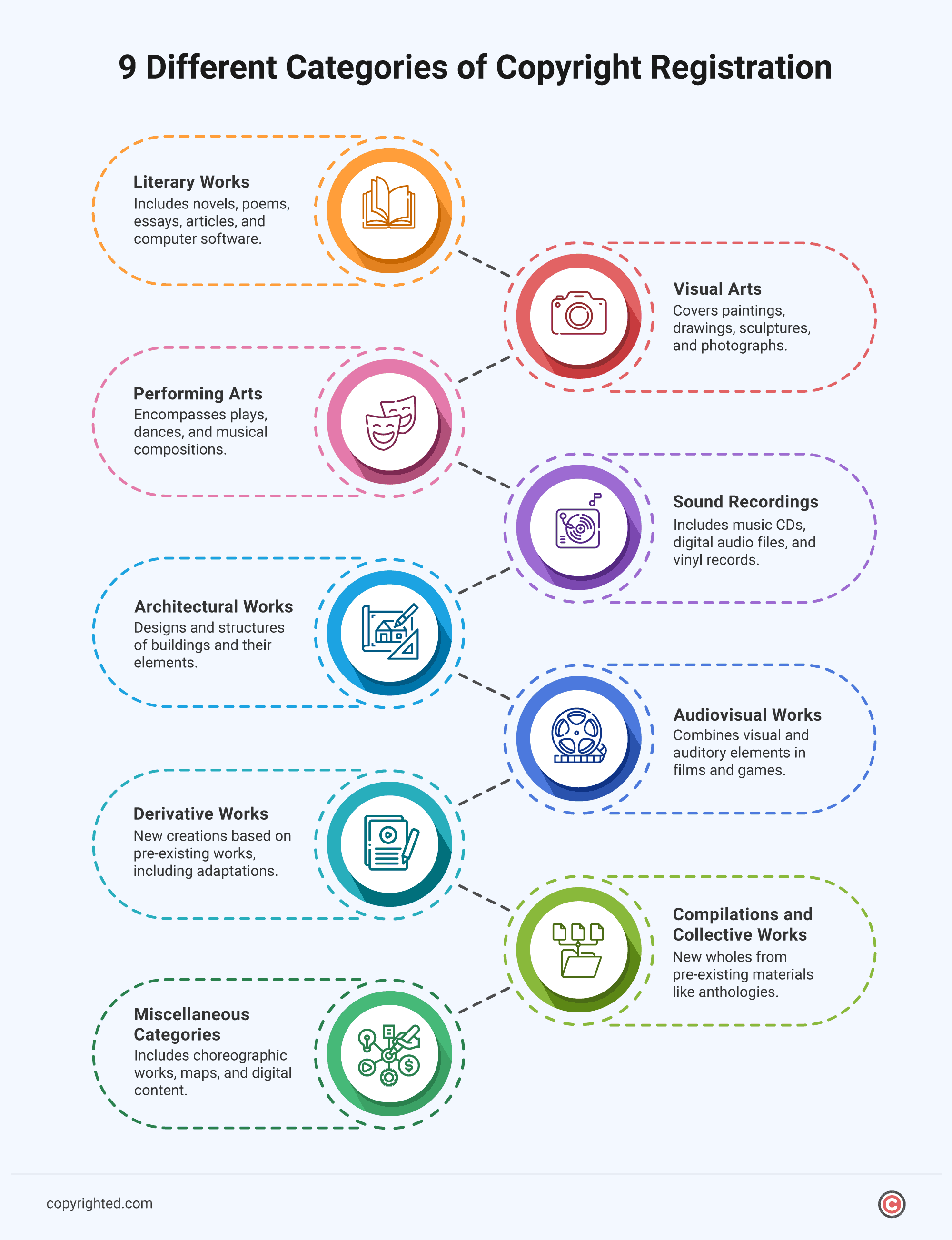Whether you’re in the midst of creating an original work or have already completed one, you may find yourself pondering its eligibility for copyright protection and the correct procedures for securing it.
This article will delve into the multifaceted world of copyrightable works, discussing the distinct categories that warrant protection under intellectual property law. We will also discuss the kinds of works that don’t match traditional copyright registration and whether you can register multiple works under one copyright application.
This post aims to guide you in understanding the categories of copyright registration and ensuring that your creative endeavors receive the protection they deserve.
- There are various types of creative works that deserve copyright protection.
- Copyright protects the expression of ideas, not the ideas themselves.
- You can register multiple categories of works under one copyright application.
Table of Contents
What Are the Different Categories of Copyright Registration?
Copyright registration involves various categories of creative works, each deserving of protection under intellectual property law. Let’s explore the different categories of copyright registration and the types of works they include.

Literary Works
Literary works include a broad range of written works, including novels, poems, essays, articles, and computer software code. These works are protected under copyright law as long as they are original and fixed in a tangible form of expression.
Visual Arts
Visual arts cover paintings, drawings, sculptures, photographs, and other visual artworks. Copyright protection extends to these works, preserving the rights of the creators to control reproduction, distribution, and public display.
Performing Arts
Performing arts features a variety of creative expressions performed live or recorded, such as plays, musical compositions, choreography, dance performances, and theatrical productions. Copyright protects the unique expressions embodied in these works.
Sound Recordings
Sound recordings involve capturing and fixing sounds onto a tangible medium, such as CDs, digital audio files, or vinyl records. Copyright protection applies to the recorded sounds themselves, separate from any underlying musical works or performances.
Architectural Works
Architectural works cover the design and structure of buildings, including both the overall architectural design and specific architectural elements. Copyright protects original architectural designs, blueprints, and drawings.
Audiovisual Works
Audiovisual works combine visual and auditory elements, such as movies, television shows, documentaries, and video games. Copyright covers the entire audiovisual presentation, including the script, storyline, characters, visuals, and soundtracks.
Derivative Works
Derivative works are new creations that are based on pre-existing copyrighted works and can include adaptations, translations, remixes, and sequels. Copyright protection extends to the original elements contributed to the derivative work.
Compilations and Collective Works
Compilations and collective works involve selecting, arranging, or assembling pre-existing materials into a new whole, such as anthologies, directories, databases, and collective works like magazines or newspapers. Copyright secures the compilation as a whole, but not the individual components unless they have independent copyright protection.
Miscellaneous Categories
Other categories of works that can be registered under copyright protection include choreographic works, pantomimes, dramatic works, pictorial, graphic, and sculptural works, as well as maps, technical drawings, and even certain types of websites or digital content. Each type may have specific requirements and considerations for copyright protection.
Are There Any Categories of Works That Cannot Be Registered for Copyright?
Exploring the boundaries of copyright law reveals certain categories of works that fall outside its protective scope. These exceptions shed light on the limitations of intellectual property rights.
Let’s talk about the categories of works that cannot be registered for copyright and the reasons behind their exclusion.
- Ideas: Copyright protects the expression of ideas, not the ideas themselves. Ideas are considered too broad and abstract to qualify for copyright protection. However, once an idea is expressed in a tangible form, such as a book or a painting, it becomes eligible for copyright protection.
- Facts: Copyright does not protect factual information or data such as historical events, scientific discoveries, news, and other information that is considered common knowledge or based on objective reality. However, the original way in which facts are presented or compiled may be eligible for copyright protection.
- Procedures, Processes, Systems, or Methods of Operation: Copyright does not extend to procedures, processes, systems, or methods of operation. These functional aspects are typically governed by patent law or other forms of intellectual property protection, rather than copyright.
- Titles, Names, Short Phrases, and Slogans: Copyright does not safeguard short phrases, titles, names, or slogans, as they are generally too brief or generic to qualify for protection, despite their significance in branding and marketing. However, they may be protected under trademark law if they are used to identify and distinguish goods or services in commerce.
- Works in the Public Domain: Works that are in the public domain are not eligible for copyright protection because they are not owned or controlled by any individual or entity. Public domain works include those whose copyright has expired, works that were never eligible for copyright protection, and works that have been explicitly dedicated to the public domain by their creators.
- Government Works: Works created by the U.S. federal government, such as federal statutes, regulations, judicial opinions, and other government documents, are typically ineligible for copyright protection under U.S. copyright law. However, individual states may have different rules regarding the copyright status of works created by state and local governments.
- Functional Elements of Design: Copyright does not protect the functional elements of a design, such as the shape, configuration, or mechanical features of an object. These aspects may be eligible for other forms of intellectual property protection, such as design patents or utility patents.
Can You Register Multiple Categories of Works Under One Copyright Application?
Yes, you can register multiple categories of works under one copyright application.
When submitting a copyright application, you have the option to include multiple works of the same or different categories in a single application, as long as they were created by the same author or authors and are being published together as a single unit of publication or are part of a single collection. This approach can save time and money compared to filing separate applications for each work.
For example, if you are a photographer publishing a book containing both your photographs and accompanying text, you can include both the photographs and the text in a single copyright application for the entire book. Similarly, if you are a musician releasing an album containing multiple songs, you can register all the songs together in one application.
However, it’s important to note that each work included in the application must meet the requirements for copyright protection individually, and the application should clearly identify each work and its category. Additionally, if the works are published separately or are not part of a single unit of publication or collection, they should be registered separately.
Registering multiple works under one application can streamline the copyright registration process. Still, it’s essential to ensure that all necessary information and documentation are provided accurately to avoid any potential issues with the registration.
Frequently Asked Questions
Are there any categories of works that cannot be copyrighted?
Yes, categories such as ideas, facts, and procedures cannot be copyrighted because copyright protects the expression of ideas, not the ideas themselves.
Do you need to register a copyright for your work to be protected?
No, copyright protection exists automatically once a work is created and fixed in a tangible form. Still, registration provides additional benefits, such as the ability to sue for infringement and the establishment of a public record of ownership.
Is copyright registration necessary for international protection?
Copyright registration in one country generally does not extend protection to other countries; however, international treaties like the Berne Convention provide some degree of reciprocity among member countries.
Do different categories of works have varying durations of copyright protection?
Yes, the duration of copyright protection varies depending on the category of the work and other factors such as the date of creation or publication.
Can you update or modify the categories of registered works after copyright registration?
No, the categories of registered works cannot be updated or modified after copyright registration; however, additional works can be registered separately if necessary.


